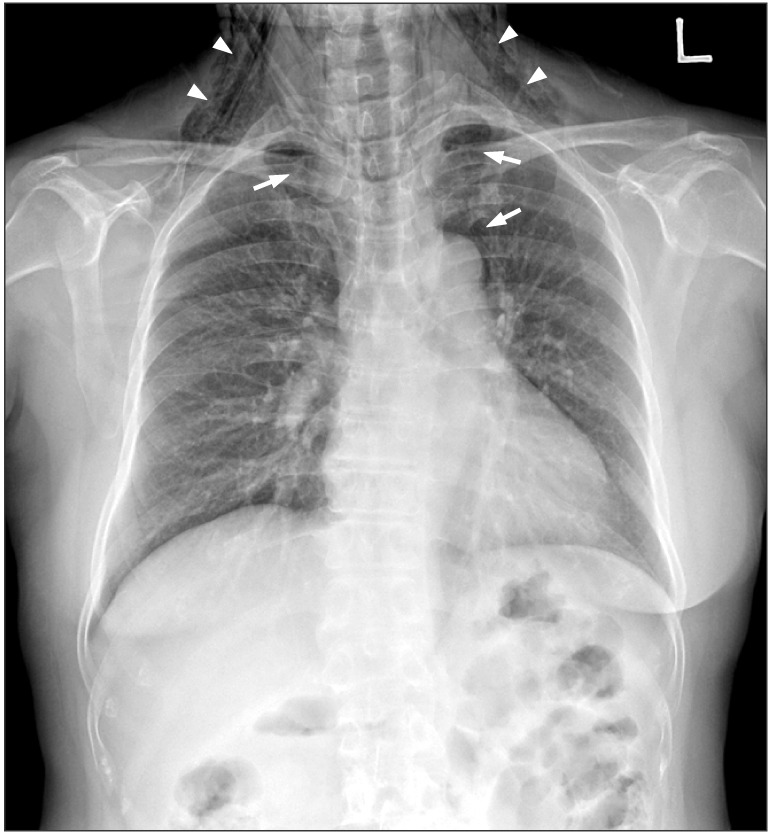Investigation of the Electric Handpiece-related Pneumomediastinum and Cervicofacial Subcutaneous Emphysema in Third Molar Surgery
Por um escritor misterioso
Descrição
Pneumomediastinum and/or cervicofacial subcutaneous emphysema are extremely rare but severe complications in third molar surgery and treatment with an electric handpiece that does not use the drive air is generally recommended; however, its safety has not been fully verified. Correspondence to: Dr. Hitoshi Yoshimura, Department of Dentistry and Oral Surgery, Unit of Sensory and Locomotor Medicine, Division of Medicine, Faculty of Medical Sciences, University of Fukui, 23-3 Matsuokashimoaizuki, Eiheiji, Fukui, 910-1193 Japan; Tel: +81-776-61-8411; Fax: +81-776-61-8128; E-mail: omfs@u-fukui.ac.jp Abstract: Pneumomediastinum and/or cervicofacial subcutaneous emphysema are extremely rare but severe complications in third molar surgery. The most common cause is compressed air exhaust from an air-driven high-speed handpiece. To prevent these complications, treatment with an electric handpiece that does not use the drive air is generally recommended; however, its safety has not been fully verified. In this study, we investigated electric handpiece-related emphysema during third molar surgery. We evaluated patients who visited our hospital in relation to third molar surgery between January 2008 and December 2017. Of the 2938 patients examined, 2 patients were complicated with electric handpiece-related pneumomediastinum and cervicofacial subcutaneous emphysema during sectioning the mandibular third molar. In these cases, a straight motor handpiece and a 1:5 speed increasing contra-angle motor handpiece were used, respectively. Both patients received antibiotics and follow-up examination under hospitalization. Although the air flow and pressure of an electric handpiece are lower than those for air-driven high-speed handpieces, the air expelled from electric handpieces could cause cervicofacial emphysema and/or pneumomediastinum. It should be noted that electric handpieces do not use the drive air; however, most of these handpieces have air/water nozzles and use tip air. Before treatment, an informed consent to patients about the risk of emphysema is mandatory. With regard to the surgical technique, elevation of the mucoperiosteal flap should be minimal. Attention should be also paid to the possibility that the air inflow route is made through removal or perforation of the cortical bone. To prevent emphysema, an electric surgical handpiece with an external water spray may be preferable for removing the bone and cutting the tooth, because this type of surgical handpiece has a separate water drip for cooling instead of combined water and air spray, and it does not use the flux of air.

Causes of subcutaneous emphysema following dental procedures: a systematic review of cases 1993-2020

Subcutaneous emphysema related to air‐powder tooth polishing: a report of three cases - Alonso - 2017 - Australian Dental Journal - Wiley Online Library

Managing Subcutaneous Emphysema Following Dental Procedures - Decisions in Dentistry

PDF) Subcutaneous Emphysema and Pneumomediastinum Secondary to Dental Extraction: A Case Report and Literature Review

IJERPH, Free Full-Text

Investigation of the Electric Handpiece-related Pneumomediastinum and Cervicofacial Subcutaneous Emphysema in Third Molar Surgery

KoreaMed Synapse

Investigation of the Electric Handpiece-related Pneumomediastinum and Cervicofacial Subcutaneous Emphysema in Third Molar Surgery
Cervicofacial and palpebral emphysema can be seen in this photograph.

PDF) Subcutaneous emphysema related to dental procedures

With two episodes of right retromandibular angle subcutaneous emphysema during right upper molar crown preparation: A case report

Iatrogenic subcutaneous facial emphysema secondary to a Class V dental restoration: a case report - Chien - 2019 - Australian Dental Journal - Wiley Online Library

Cervicofacial subcutaneous emphysema and pneumomediastinum secondary to dental treatment in a young man - ScienceDirect

PDF] Cervicofacial and mediastinal emphysema complicating a dental procedure.
de
por adulto (o preço varia de acordo com o tamanho do grupo)






:max_bytes(150000):strip_icc()/can-still-eat-bruised-rotten-produce-getty-0223-2000-80ac09a994334e5eb0989c9a01c97673.jpg)
